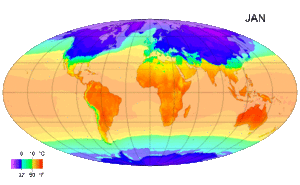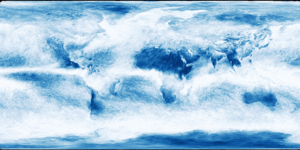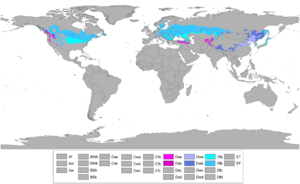Climate facts for kids
Climate is the usual weather conditions in a place over a very long time. This includes things like how hot or cold it usually is, how much rain or snow falls, how windy it gets, and how humid the air feels. Climate is different from weather, which is what the air is like right now or over a few days.
Many things can affect a place's climate. These include its latitude (how far it is from the equator), its height above sea level, and if it's near large bodies of water like oceans. Scientists often group climates based on their typical temperature and precipitation (rain, snow, etc.). One common way to classify climates is the Köppen climate classification system. Another system, called Thornthwaite, also looks at how much water evaporates from the ground and plants. This helps scientists study different animal and plant species and understand how climates might change.
Contents
Understanding Climate Change
Climates on Earth can change over very long periods. Recently, many people talk about global warming, which means the world's average temperature might be getting warmer.
When we talk about "climate change" today, it often means the changes happening to our climate right now. This includes the rise in average surface temperature. Sometimes, this term also suggests that human activities are causing these changes.
Climate change means that global or local climates are changing over time. These changes can happen over decades or even millions of years. They can be caused by natural processes on Earth, outside forces like changes in sunlight, or, more recently, by human activities.
Different Climates Around the World
The climate of a place can be described in different ways:
Rainforests
Rainforests get a lot of rain. They usually receive between 1750 mm and 2000 mm of rain each year. The average monthly temperatures are always above 18°C (64°F).
Monsoon Climates
A monsoon is a strong seasonal wind that brings a region's rainy season. These winds last for several months. Monsoon climates are found in parts of North America, South America, Sub-Saharan Africa, Australia, and East Asia.
Tropical Savannas
A tropical savanna is a grassland area. It has average temperatures of 18°C (64°F) or higher all year. Rainfall is usually between 750 mm and 1270 mm annually. Savannas are common in Africa and also found in India, northern South America, Malaysia, and Australia.
Humid Subtropical Climates
The humid subtropical climate zone has wet winters, sometimes with snow. These wet conditions come from large storms moving from west to east. Most summer rain comes from thunderstorms and sometimes tropical cyclones. These climates are usually on the east side of continents, roughly between 20° and 40° latitude from the equator.
Humid Continental Climates
A humid continental climate has changing weather and big temperature differences between seasons. Places with this climate have more than three months where the average daily temperature is above 10°C (50°F). The coldest month's temperature is below -3°C (27°F). These areas are not considered dry or semi-dry.
Oceanic Climates
An oceanic climate is usually found along the west coasts of continents in the middle latitudes. It is also in southeastern Australia. These areas get plenty of rain all year round.
Mediterranean Climates
The Mediterranean climate is like the climate around the Mediterranean Sea. It's also found in parts of western North America, parts of Western and South Australia, southwestern South Africa, and central Chile. This climate has hot, dry summers and cool, wet winters.
Steppe Climates
A steppe is a dry grassland. Temperatures can vary greatly, from up to 40°C (104°F) in summer to down to -40°C (-40°F) in winter.
Subarctic Climates
A subarctic climate has little rain or snow. Monthly temperatures are above 10°C (50°F) for only one to three months a year. Large parts of these areas have permafrost (ground that is always frozen) because of the very cold winters. Winters often have temperatures averaging below 0°C (32°F) for up to six months.
Tundra Climates
Tundra areas are in the far Northern Hemisphere. They are north of the taiga (forest) belt. This includes huge parts of northern Russia and Canada.
Polar Ice Caps
A polar ice cap is a very cold region at high latitudes. It is covered in thick ice. Ice caps form because these regions get less energy from the sun than areas near the equator. This results in very low surface temperatures.
Desert Climates
A desert is a place that gets very little rain or snow. Deserts usually have big temperature changes between day and night, and between seasons. Daytime temperatures can be very high (up to 45°C or 113°F in summer). Nighttime temperatures can be very low (down to 0°C or 32°F in winter). This is because the air is extremely dry. Many deserts form in "rain shadows," where mountains block moisture from reaching them.
See also: Köppen's climate classification scheme
See also
 In Spanish: Clima para niños
In Spanish: Clima para niños









